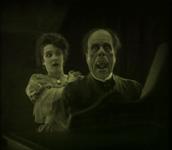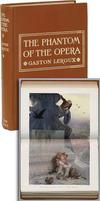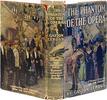directed by Rupert Julian
screenplay by Elliott Clawson
after the novel Le Fantôme de l’Opéra (1910) by Gaston Leroux
79 min.
This movie has a complicated history in addition to having been a complicated collaboration, and the credits above don’t really do justice to any of that. But oh well. You can go read about it on one of the thousand “Phantom of the Opera” fan sites out there.
(1925/1929) because the original 1925 release of the movie was heavily reworked with new material for a re-release in 1929, and that’s the version that’s generally seen, sort of. It’s the version I saw last week, anyway. Sort of. Like I said, check your local library for details.
People say that this movie is still creepy, that it has remained effective as horror, etc. That’s sweet to say, but it’s misleading. To watch an old movie sympathetically, especially as stiff and stagy a movie as this, you have to accommodate all the dated mannerisms and absurdities; you have to translate from the dead filmic language of the era. That translation process, to me, sometimes feels like internal amplification: the movie shows me something that, because it is so dated, imparts only a very slight emotional effect to me, and then I intentionally amplify that emotion so that I can see it as important. The amplification is my responsibility, and no matter how subconsciously I do it, I’m always quite capable of not doing it. What I’m saying is that since this movie is inescapably of its time, it feels fundamentally harmless. Real horror needs to feel threatening. I always felt that I was much, much less frightened than the people on screen. I don’t think that’s true for, say, Dracula (1931) or Nosferatu (1922), which each contain moments that still manage to have a true, sustaining creepiness.
But The Phantom of the Opera definitely has stuff in it that’s aged very well. Lon Chaney’s phantom face was both effective as “horrible” and also kind of fun to look at; I kept hoping we would see more of it. The movie seemed most alive when his ugly face was on screen. The version we saw had a very attractive restoration/recreation of the original “hand-tinting” of his red cape in the scene on the rooftop. The sheer intensity of that unearthly billowing blotch of color was also still pretty exciting.
The effect of the movie is pretty well summed up by the scene (apparently famous but I’d never seen it before) when the phantom is first unmasked. Suspense builds up and then with a calculated suddenness, his pruny face is screaming right at the camera.
It’s clearly a bald attempt to scare everyone as much as possible, and it’s fun and exciting as such. On the other hand, it’s basically the facial equivalent of the venerable word “Boo!” and about as effective. “Boo!” isn’t horror, it’s “horror,” and so is this movie. It’s showmanship circa 1925, and that’s fun to see. But while the source story seems to contain a note of actual subterranean creepiness, this movie is pretty much just a melodrama about a crazy man who kidnaps a pretty girl.
Of course, I’ve never read the source material, and I didn’t know much about it until I started poking around online a few days ago. It’s really pretty schlocky stuff! Somehow Hollywood had tricked me into believing that The Phantom of the Opera was some kind of literature and that “Gaston Leroux” pretty much just meant “Victor Hugo.” But no. Gaston Leroux was a potboiler schlockmeister! I guess I could have guessed that from the presence of a character named “Raoul.” Not to mention “Erik.”
The first editions of Le Fantôme had several charming illustrations by André Castaigne that were quite explicitly restaged in the movie. You can see them all linked from this page. The picture below, of the first American edition, was pulled from Abebooks.com, where it’s going for $1450.
Here are the jackets of a few other Leroux works found on Abebooks (as well as the “Photoplay” edition of Phantom and a pulpy later one). I must admit my curiosity is piqued. A brief bio online ends with these tantalizing sentences:
In the novella The Burgled Heart (tr. 1925) Leroux employed supernatural elements – the astral body of a French woman is abducted by an English artist. The Kiss that Killed (tr. 1934) and The Machine to Kill (tr. 1935) featured a vampire and a robot as murderers.
I saw The Phantom of the Opera at an outdoor screening, which was cool, accompanied live by the Alloy Orchestra, who I tend to think are a bit overrated. I’m glad that they do this sort of thing, and I even like that they use unusual instrumentation – the musical saw was an excellent choice for The Phantom, I thought – but as film composers they just aren’t so hot. For The Phantom, they did what anyone would do: they wrote a lugubrious little main theme featuring organ (natch) under a musical saw “ghostly voice” melody. Musically it sounded like something out of Amélie. It wasn’t bad, as far as it went, but though it sounded like it might well portray a “Phantom of The Opera,” it didn’t live very comfortably with this particular movie itself. In fact, they had the phantom playing it during his scene at the organ, despite the fact that he is explicitly shown to be playing “Don Juan Triumphant,” the opening bars of which are shown on the screen – typical fanfares and such. The intertitles have him saying something like, “Listen! It is the triumph of love! But underneath, do you hear it? A note of warning!” Meanwhile the Alloy Orchestra is rocking away confidently at their cobwebby variation on “Zelda Dungeon.”
The end of the movie (in this version) is a big chase through the streets of Paris. Alloy resorted to pounding on their gongs and anvils whenever it was time to indicate action, which maybe works for a minute, but not for three minutes. Monotonous accompaniment is a disservice to the picture – it’s like the music is saying, “well, this is all basically the same kind of stuff, building up.” I felt like Alloy was making the scene boring. If I’ve learned anything from John Williams, it’s that good action scoring treats every stupid little thing like it’s a big deal. Star Wars would fall completely flat on its face if that music wasn’t there telling us that every explosion matters. Or else it takes the long view and portrays it all as epic. Alloy could easily have made the phantom’s final chase into the height of tragedy by playing truly against the action and having the musical saw sing over it all. But no; they chose to play the action in the dumbest way possible. I was frustrated.
I was also frustrated that all the opera and ballet performance scenes were scored with that same crappy fake-classical synthesizer junk you hear all over the place. You know, the bad fake oboe sound and the bad fake pizzicato sounds twiddling around ineffectually. That stuff always makes me feel like I’m drinking discolored post-Froot Loops milk. Uugh.
By far the best modern scores for silents are those by Carl Davis, and I see he did one for the Phantom. I want to see that and compare.
One last thing: at this showing, the second projector burned out spectacularly in the middle of the movie, with a puff of smoke, and so after that point, we had to stop and wait for a minute or two during reel changes. That was a throwback I’d never really thought about before, but I enjoyed it. It took me back to a time when movies were still finding their own feet, formally. This movie had chapters! It was like turning the page to see what happens next, or waiting for the next installment of a serialized novel. To their credit, Alloy improvised appropriately through the breaks, which strongly suggested operatic “scene change music”, or even vaudevillian scene change music. I think it would actually be a nice thing for a group like Alloy to intentionally work in: brief, pre-composed musical interludes between reels. There’s something classical and satisfying about formal divisions like those when they’re done wholeheartedly.
Afterthought, a few hours later: it’s not really right for me to dismiss the unmasking scene as “not actual horror,” when it would have, I’m quite sure, scared all the willies out of me when I was younger. I’m still quite susceptible to the “scary face in your face!” school of scares. A movie that has a scary enough face lurking somewhere in it is for me completely suffused with horror, because it is indeed “threatening.” So my sense that this movie wasn’t really scary was due primarily to my comfort with Lon Chaney’s pig-nose and puffy cheeks. But that’s just me, and me as I am now. If you think his face is scary, the movie works, because it has that weapon and uses it pretty well. And yes, the makeup has aged well; as I said, there’s something magnetic about that face. So I understand why people say this movie retains power. It’s a credit to Lon, who designed the makeup himself.








